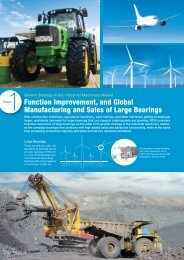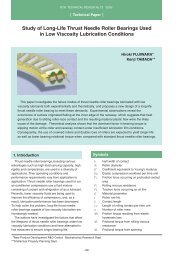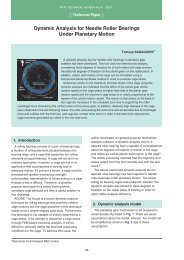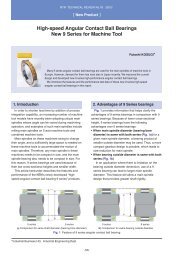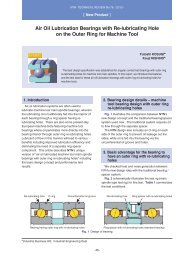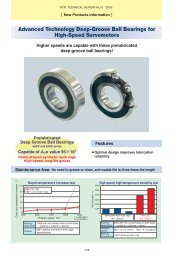Special Issue; Products for Industrial Machinery - NTN
Special Issue; Products for Industrial Machinery - NTN
Special Issue; Products for Industrial Machinery - NTN
You also want an ePaper? Increase the reach of your titles
YUMPU automatically turns print PDFs into web optimized ePapers that Google loves.
<strong>NTN</strong> TECHNICAL REVIEW No.742006<br />
New Product <br />
Development of Aerostatic Bearing Spindle<br />
<strong>for</strong> Precision Machine Tools<br />
Teruyoshi HORIUCHI<br />
Kazuyuki AONO<br />
Hiroaki HIYOSHI<br />
The main reasons <strong>for</strong> aerostatic bearing spindles in<br />
precision machining are the increase in stiffness and reduction<br />
of thermal displacement of the work. To meet such demands,<br />
<strong>NTN</strong> has developed a new aerostatic bearing spindle <strong>for</strong><br />
precision machining by reviewing the bearing design, cooling<br />
mechanism, and material selection. The results of the<br />
per<strong>for</strong>mance evaluation test of the prototype air bearing<br />
spindle are described here.<br />
1. Introduction<br />
As the demand <strong>for</strong> personal digital equipment,<br />
including mobile phones and DVD recorders, has<br />
increased, there has been a growing need to improve<br />
productivity the machining precision dies <strong>for</strong> aspheric<br />
lenses and other precision components. Ultraprecision<br />
machine tools <strong>for</strong> machining very small<br />
precision dies <strong>for</strong> these components often employ<br />
precision aerostatic spindles that incorporate<br />
hydrostatic air bearings. To improve the productivity of<br />
these machine tools, their aerostatic bearing spindles<br />
must be capable of both higher running speed and<br />
greater precision.<br />
<strong>NTN</strong> has long been providing high-precision<br />
aerostatic bearings that are used on original recording<br />
devices <strong>for</strong> optical disks, as well as on magnetic disk<br />
inspection devices. By further advancing our<br />
aerostatic bearing spindle technology, we have<br />
successfully developed a high-speed, high-precision<br />
aerostatic bearing product <strong>for</strong> precision machine tools.<br />
2. Challenges <strong>for</strong> Aerostatic Bearing<br />
Spindles <strong>for</strong> Machine Tools<br />
Generally, an aerostatic bearing spindle is<br />
comprised of two journal bearings that support the<br />
rotary shaft in the radial direction, a pair of thrust<br />
bearings that support the rotary shaft in the axial<br />
direction, a driving AC servomotor, and a rotary<br />
encoder <strong>for</strong> detecting the running speed of the<br />
spindle, as illustrated in Fig. 1. The rotary shaft is<br />
supported by the bearings without contacting them by<br />
using the pressure of an air layer that is several<br />
micrometers thick. The motor and the rotary encoder<br />
are also non-contact types. Since the rotary shaft is<br />
supported without contacting fixed members, the<br />
frictional resistance on the rotary shaft is limited,<br />
allowing the rotary motion of the rotary shaft to be<br />
controlled very accurately.<br />
In addition to the fundamental structure described<br />
above, as with any other aerostatic bearing spindle <strong>for</strong><br />
precision machine tools, the spindle needs to<br />
incorporate a bearing arrangement <strong>for</strong> high spindle<br />
rigidity, a high-torque motor that provides the torque<br />
necessary <strong>for</strong> the intended machining operation, and a<br />
vacuum chuck mechanism to hold workpieces in<br />
position with vacuum <strong>for</strong>ce. Also, measures against<br />
thermal de<strong>for</strong>mation resulting from heat generation on<br />
the motor and bearings will be necessary in the <strong>for</strong>m<br />
of a cooling mechanism. Furthermore, since the<br />
environments where the aerostatic bearing spindles<br />
<strong>for</strong> precision machine tools are situated differ from the<br />
environments in which aerostatic bearing spindles <strong>for</strong><br />
inspecting devices are used, a sealing mechanism<br />
must be provided <strong>for</strong> the <strong>for</strong>mer in order to prevent<br />
ingress of chips and coolant mist.<br />
Product Engineering Department Precision Equipment Division<br />
-34-



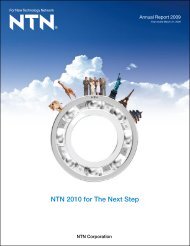
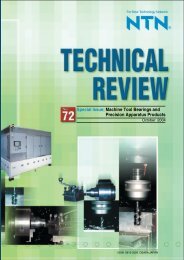
![[New Product] Unit Products for Office Equipment - NTN](https://img.yumpu.com/27154451/1/184x260/new-product-unit-products-for-office-equipment-ntn.jpg?quality=85)
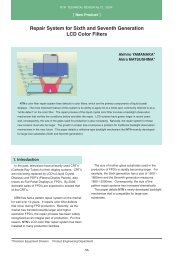
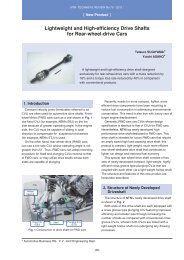
![[New Product] Development of Oil-impregnated Sintered ... - NTN](https://img.yumpu.com/27154427/1/184x260/new-product-development-of-oil-impregnated-sintered-ntn.jpg?quality=85)

